Mold Testing & Mold Remediation
Yes mold spores are everywhere, so wherever you are right now there is mold in the room. You are breathing in a background level of Mold. (We are assuming you don't see any mold). Now let's move into a room where mold is visible, meaning you see staining, and you might even smell a musty odor. (Musty is mold off-gassing because it is actively growing). You see the staining on the wallpaper and you pull it off the wall and you see the following:

What did you learn? That mold is everywhere but it is invisible, but when you see mold you don't just have mold you have a lot of mold. If you see mold you need to clean it up.
Contrary to the belief of people selling their homes, mold is not a selling feature. Have you ever heard 3 bedrooms, 2.5 baths, granite counter tops and mold in the basement? Probably not.
If you checked into a hotel and found mold, you would want another room. Visible mold indicates a problem.
Why do you have mold?
Mold growth can be found on any organic surface providing the right amount of moisture and oxygen are present. Mold needs moisture and humidity, if you have mold, you created the perfect environment for mold to grow and exist. First, you have a water problem, next you have a mold problem. Fix the water problem, fix the mold problem. Some molds are specific to certain building materials including drywall, fiberboard tiles, wood, flooring materials and furniture.
The three most common areas for mold growth are crawl spaces, basements, and attics. The reason being none of these areas are conditioned (heated and cooled). Unconditioned spaces allow the right temperature and moisture levels that will allow periodic mold growth. You see you don't need a burst pipe or flood to cause mold.
Example of Mold Remediation in the attic.


Why is mold a concern?
The mold concern is health-related, it is known that mold growing indoors creates indoor air pollution, which can affect the health of building occupants.
Molds can produce allergens, irritants, and sometimes potentially toxic substances (mold consumes organic material and as part of the digestive process you can get off tasing or byproducts that are harmful to human health.
Molds can produce allergic reactions or even asthma attacks. Molds can also irritate the eyes, nose, throat and lungs.
How do you inspect for mold?
The way you professionally inspect for mold is by calling a company like Curren Environmental, who has years of experience with mold inspections, thousands of mold remediation project completed and will provide a free initial (phone) consultation for your situation. Our project managers can test and determine the type of mold that is present and present recommendation on treatment, cause and prevention.




Mold Remediation
Mold remediation is the removal of mold. Simply killing the mold with bleach will not take away the health risks of mold as dead mold spores can be inhaled and become an irritants to humans.
Mold remediation follows asbestos abatement guidelines, meaning procedures are followed to protect areas where mold is not present (containment), protection of the personnel doing the remediation (protective clothing and respiratory protection), removal of the mold (heap vacuuming, wiping and sometimes physical removal of the mold impacted material), fungicidal application to kill spores that could be airborne or missed during the first cleaning process, air scrubbing and lasting a protective coating to prevent future growth.



With over 26 years of experience
our crews have completed thousands of projects successfully.



